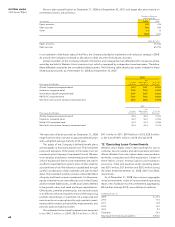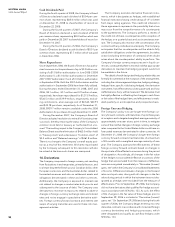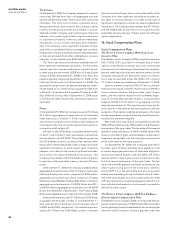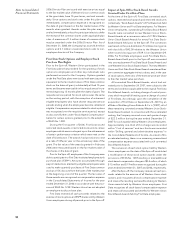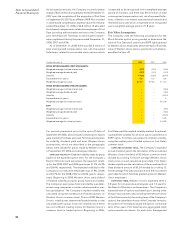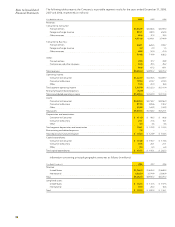Western Union 2008 Annual Report Download - page 80
Download and view the complete annual report
Please find page 80 of the 2008 Western Union annual report below. You can navigate through the pages in the report by either clicking on the pages listed below, or by using the keyword search tool below to find specific information within the annual report.WESTERN UNION
2008 Annual Report
7878
term is primarily based on the results of a study performed
on the historical exercise and post-vesting employment ter-
mination behavior for similar grants. First Data’s expected
terms were as follows: 4.5 years for non-executive employ-
ees, 7 years for the Board of Directors and 7.5 years for its
executives. The expected term of ESPP rights were deter-
mined to be 0.25 years as purchase rights are achieved
over the course of the quarter in which the employee
participated in the ESPP. Once the shares have been pur-
chased, the employee can sell their respective shares.
RISK-FREE INTEREST RATE—The risk-free rate for stock
options granted during the period is determined by using
a U.S. Treasury rate for the period that coincided with the
expected terms listed above.
The assumptions used to calculate the fair value of
options granted will be evaluated and revised, as neces-
sary, to reflect market conditions and the Company’s histori-
cal experience and future expectations. The calculated fair
value is recognized as compensation cost in the Company’s
financial statements over the requisite service period of the
entire award. Compensation cost is recognized only for
those options expected to vest, with forfeitures estimated
at the date of grant and evaluated and adjusted periodi-
cally to reflect the Company’s historical experience and
future expectations. Any change in the forfeiture assump-
tion will be accounted for as a change in estimate, with
the cumulative effect of the change on periods previously
reported being reflected in the financial statements of
the period in which the change is made. In the future, as
more historical data is available to calculate the volatility of
Western Union stock and the actual terms Western Union
employees hold options, expected volatility and expected
term may change which could substantially change the
grant-date fair value of future stock option awards and,
ultimately, the recorded compensation expense.
17. Segments
As previously described in Note 1, the Company classifies
its businesses into two reportable segments: consumer-
to-consumer and consumer-to-business. Operating seg-
ments are defined by SFAS No. 131, “Disclosures About
Segments of an Enterprise and Related Information,” as
components of an enterprise which constitute businesses,
about which separate financial information is available that
is evaluated regularly by the Company’s chief operating
decision maker (“CODM”) in deciding where to allocate
resources and in assessing performance.
The consumer-to-consumer reporting segment is
viewed as one global network where a money transfer
can be sent from one location to another, anywhere in
the world. The segment is now managed as two regions,
primarily to coordinate agent network management and
marketing activities. The CODM makes decisions regard-
ing resource allocation and monitors performance based
on specific corridors within and across these regions,
but also reviews total revenue and operating profit of
each region. These regions frequently interact on trans-
actions with consumers and share processes, systems
and licenses, thereby constituting one global consumer-
to-consumer money transfer network. Each region and
corridor also offer generally the same services distrib-
uted by the same agent network, have the same types
of customers, are subject to similar regulatory require-
ments, are processed on the same system, and have simi-
lar economic characteristics, allowing the geographic
regions to be aggregated into one reporting segment.
Consumer-to-consumer segment revenue typically
increases sequentially from the first quarter to the fourth
quarter each year and declines from the fourth quarter to
the first quarter of the following year. This seasonal fluctua-
tion is related to the holiday season in various countries
in the fourth quarter.
All businesses that have not been classified into
consumer-to-consumer or consumer-to-business are
reported as “Other.” These businesses primarily include the
Company’s money order and prepaid services businesses.
The Company’s reportable segments are reviewed
separately below because each reportable segment repre-
sents a strategic business unit that offers different products
and serves different markets. The business segment mea-
surements provided to, and evaluated by, the Company’s
CODM are computed in accordance with the following
principles:
º
The accounting policies of the reportable segments
are the same as those described in the summary of
significant accounting policies.
º
Corporate and other overhead is allocated to the seg-
ments primarily based on a percentage of the seg-
ments’ revenue.
º
Expenses incurred in connection with the development
of certain new service offerings, including costs to
develop mobile money transfer services, new prepaid
service offerings and non-recurring costs incurred to
effect the Spin-off are included in “Other.”
º
Restructuring and related activities of $82.9 million for
the year ended December 31, 2008 have not been allo-
cated to the segments. While these items are identifi-
able to the Company’s segments, they are not included
in the measurement of segment operating profit pro-
vided to the CODM for purposes of assessing seg-
ment performance and decision making with respect
to resource allocation. For additional information on
restructuring and related activities refer to Note 3.
º
In connection with the change in control of First Data,
the Company incurred an accelerated stock-based com-
pensation vesting charge of $22.3 million during the
year ended December 31, 2007. Of the $22.3 million
charge, $18.9 million, $3.0 million and $0.4 million were
allocated to the consumer-to-consumer, consumer-to-
business and other segments, respectively.
º
All items not included in operating income are
excluded.


